
Ulrike Kindl (born 16 October 1951 in Merano) is an Italian folklorist and professor at the University Ca' Foscari in Venice, Dipartimento di Scienze del Linguaggio. [1]

Ulrike Kindl (born 16 October 1951 in Merano) is an Italian folklorist and professor at the University Ca' Foscari in Venice, Dipartimento di Scienze del Linguaggio. [1]
Kindl studied German Studies, [2] Medieval Studies and Linguistics at the Universities of Venice, München and Ost-Berlin. In 1974, she graduated in foreign literature from Ca' Foscari in Venice. She stayed there and in December 1974 was offered a position as an assistant at the university's Institute for German Language and Literature. [3] At the same time, she deepened her German studies and worked on problems and methods of didactics. [1] Between 1978 and 1986, she studied at the Humboldt University in East Berlin and at the Institute for German as a Foreign Language at the University of Munich. [1]
Since 1980, her research has focused on the field of folkloristic narrative research, fairy tales and legends of the Alpine region, as well as the points of contact between folk and art fairy tales.
In 1986 Ulrike Kindl became associate professor of German Language and Literature at Ca' Foscari University. [1]
In addition to her university work, she is a research assistant in the field of folkloristics at the Ladin cultural institutes "Majon di Fascegn" (Vigo di Fassa, Trentino) and "Micurá de Rü" (St. Martin in Thurn, South Tyrol).

Ladin is a Romance language of the Rhaeto-Romance subgroup, mainly spoken in the Dolomite Mountains in Northern Italy in the provinces of South Tyrol, Trentino, and Belluno, by the Ladin people. It exhibits similarities to Romansh, spoken in Switzerland, as well as Friulian, spoken in north-east Italy.
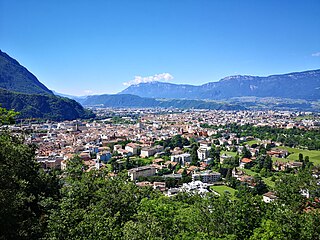
Bolzano is the capital city of the province of Bolzano - South Tyrol, in Northern Italy. With a population of 108,245, Bolzano is also by far the largest city in South Tyrol and the third largest in historical Tyrol. The greater metro area has about 250,000 inhabitants and is one of the urban centres within the Alps.

Trentino-Alto Adige/Südtirol is an autonomous region of Italy, located in the northern part of the country. The region has a population of 1.1 million, of whom 62% speak Italian as their mother tongue, 30% speak South Tyrolean German and several foreign languages are spoken by immigrant communities. Since the 1970s, most legislative and administrative powers have been transferred to the two self-governing provinces that make up the region: the province of Trento, commonly known as Trentino, and the province of Bolzano, commonly known as South Tyrol. In South Tyrol, German remains the sizeable majority language.

Merano or Meran is a comune (municipality) in South Tyrol, Northern Italy. Generally best known for its spa resorts, it is located within a basin, surrounded by mountains standing up to 3,335 metres above sea level, at the entrance to the Passeier Valley and the Vinschgau.
The Prontuario dei nomi locali dell'Alto Adige is a list of Italianized toponyms aimed at replacing the place names used by the German language community in South Tyrol which was published in 1916 by the Royal Italian Geographic Society. The list was called the Prontuario in short and later formed an important part of the Italianization campaign initiated by the fascist regime, as it became the basis for the official place names in the predominantly German-speaking Italian-annexed southern part of the County of Tyrol.

San Martin de Tor is a comune (municipality) and a village in South Tyrol in northern Italy, located about 45 kilometres (28 mi) northeast of the city of Bolzano.
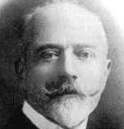
Ettore Tolomei was an Italian nationalist and fascist. He was designated a Member of the Italian Senate in 1923, and ennobled as Conte della Vetta in 1937.
Joseph Pasquale Crazzolara was a Christian missionary in Africa, an ethnologist and a linguist.
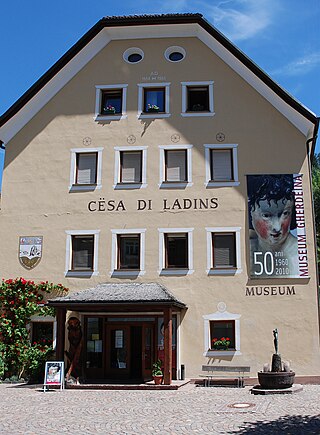
The Gherdëina Local Heritage Museum was opened in the Cësa di Ladins in Urtijëi, in northernmost Italy, in 1960. The building is the seat of the Union di Ladins de Gherdëina a cultural organisation for the keeping of the Ladin language and heritage in Val Gherdëina. In addition to the museum, the building hosts a library specialized in Ladin language and culture.

Wilfried Senoner was an Italian artist.

The Ladins are an ethnolinguistic group of northern Italy. They are distributed in several valleys, collectively known as Ladinia. These include the valleys: of Badia and Gherdëina in South Tyrol, of Fassa in the Trentino, and Livinallongo and Ampezzo in the Province of Belluno. Their native language is Ladin, a Rhaeto-Romance language related to the Swiss Romansh and Friulian languages. They are part of Tyrol, with which they share culture, history, traditions, environment and architecture.

The Questione Ladina is a controversy over whether the Romance languages of Romansh, Ladin, and Friulian form a proper language subfamily or should rather be regarded as a part of a wider Northern Italian dialect continuum. Both the idea of a distinctive language sub-family and the denial of a Ladin unity still have strong proponents, the former especially among Swiss, German and Austrian, the latter among Italian linguists. The issue has political implications beyond the linguistic controversy, as the areas involved have been subjects of territorial disputes, especially during the first half of the 20th century.
Ladin Dolomitan or standard Ladin is the standard written constructed language (Dachsprache) based on the similarities of the five main dialect-groups of Ladin. It is the desired outcome of the project called SPELL under the initiative of The Union Generala di Ladins dles Dolomites and the Ladin cultural institutes Micurà de Rü,Majon di Fascegn and Istitut Pedagogich Ladin to create a unified standard written language.
The following is a timeline of the history of the city of Bolzano/Bozen in the Trentino-South Tyrol region of Italy.
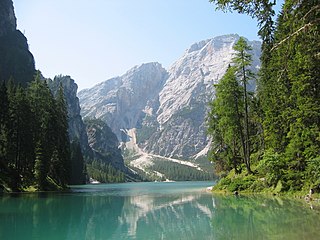
The Kingdom of Fanes is the national epic of the Ladin people in the Dolomites and the most important part of the Ladin literature. Originally an epic cycle, today it is known through the work of Karl Felix Wolff in 1932, gathered in his book Dolomitensagen. Until that time, this material was transmitted orally among the Ladin people. This legend is part of the larger corpus of the South Tyrolean sagas, whose protagonists are the Fanes themselves.

Douglas Wilson Johnson (1878–1944) was an American geographer and geomorphologist known for his contributions to the understanding of coastal processes and landforms.

Franz Tavella was a Ladin master wood sculptor active in the Austro-Hungarian Empire and the Kingdom of Italy.

Johann Baptist Moroder was an Austrian sculptor. He mainly focused on sculptures of bigger sizes representing Christian sacred figures; nowadays his works are mainly spread in the Italian region of Alto Adige.
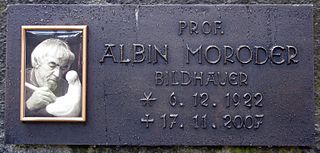
Albin Moroder was an Austrian sculptor.
Micurà de Rü, born Nikolaus Bacher, was an Austrian Ladin-speaking Catholic presbyter and linguist best known for his writings on the Ladin language.